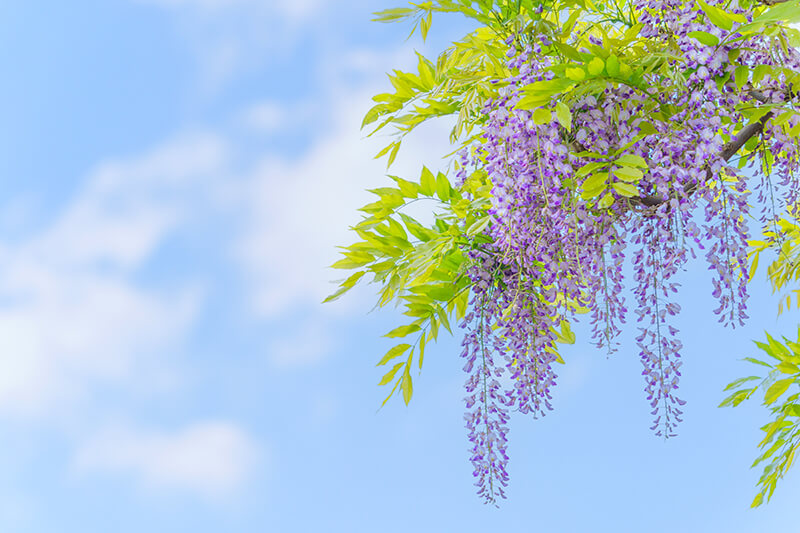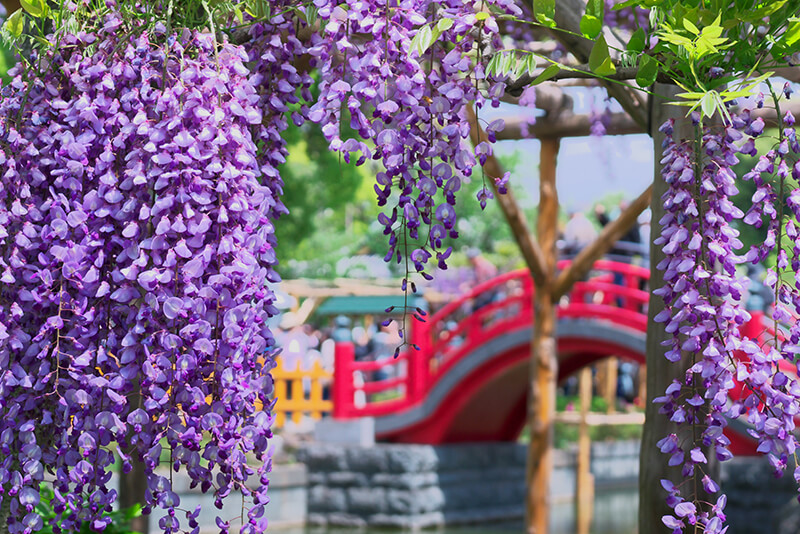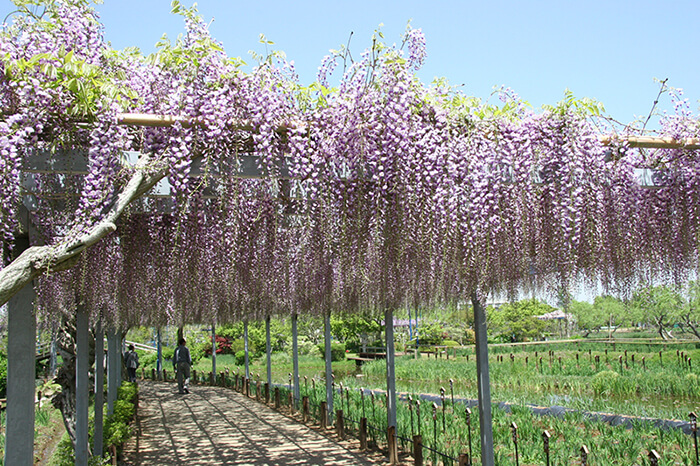
Japanese wisteria (fuji) bloom from April to May, making them the third major event on the country’s floral calendar (after the plum and cherry blossoms). What makes these delicate purple blooms unique? In a word, motion. Ancient poets called the rippling of wisteria in the wind “wisteria waves,” and the twelfth-century Emperor Go-Shirakawa wrote a song about wisteria and willow swaying and intertwining in the spring breeze as a playful metaphor for romantic dalliances. Spectacular as the blossoms are in pictures, seeing the wisteria waves in person adds a whole new dimension to the experience.
We’ve put together a list of five places in and around Tokyo where you can have that experience for yourself. Many of these locations hold special events when their wisteria are in bloom, but the exact dates change from year to year, so be sure to check in advance before you go.
-
01
1. Kameido Tenjin Shrine (Tokyo)
![The taiko bridge viewed through wisteria curtains at Kameido Tenjin Shrine]()
The taiko bridge viewed through wisteria curtains at Kameido Tenjin Shrine
If the scenery at Kameido Tenjin Shrine looks familiar, you might be recalling one of the many famous ukiyo-e prints depicting its beauty. Monet was so taken by Hiroshige’s Wisteria at Kameido Tenjin Shrine (1856) that he built a similar Japanese-style bridge over the pond in his own garden. Today’s vermillion bridge is a postwar reconstruction, but Kameido Tenjin Shrine remains one of Tokyo’s most beloved wisteria-viewing destinations, with a tranquil pond to reflect the lush blossoms dangling overhead and an annual Wisteria Festival that dates back centuries. The quiet shitamachi setting is another plus.
![Nearby Tokyo Skytree adds a modern element to ukiyo-e-inspired compositions]()
Nearby Tokyo Skytree adds a modern element to ukiyo-e-inspired compositions
Access: Kameido Tenjin Shrine is 15 minutes’ walk north of Kameido Station on the JR Chuo-Sobu Line.
-
02
2. Ashikaga Flower Park (Tochigi)
![Usubeni (pale pink) wisteria at Ashikaga Flower Park]()
Usubeni (pale pink) wisteria at Ashikaga Flower Park
Ashikaga Flower Park might be the best known wisteria spot in Japan. You can’t argue with the scale—350 wisteria trees (with 5,000 azaleas also blooming around the same time) across a park of 9 hectares. The park’s “Great Fuji” tree has a spectacular 1,000 square meter canopy, and there are not one but two “wisteria tunnels” to walk through, one golden yellow and the other pearlescent white. Because, oh yes, Ashikaga Flower Park has wisteria in many shapes and colors alongside the familiar purple variety, all blooming at slightly different times to create an ever-changing wisteria wonderland. During the park’s “Wisteria Story” (Fuji no Hana Monogatari) event, evening illumination creates an extra-phantasmagorical experience.
![Under Ashikaga Flower Park’s “Great Fuji” at night]()
Under Ashikaga Flower Park’s “Great Fuji” at night
Access: Ashikaga Flower Park is right next to Ashikaga Flower Park Station on the JR Ryomo Line, about two hours from Tokyo.
-
03
3. Haijima Park (Tokyo)
![The wisteria trellis in Haijima Park]()
The wisteria trellis in Haijima Park
In Tokyo’s far west, just outside Chichibu Tama-Kai National Park, stands Haijima Park, where the wisteria once grew wild on the precincts of Meioin temple. The temple is long gone, but the wisteria remains. In fact, it’s one of the largest and oldest wisteria trees in Tokyo. At an estimated eight centuries of age, it was photosynthesizing its first meals back when Yoritomo was founding the first shogunate in Kamakura (and Tokyo was still a fishing village called Edo!).
While in Haijima Park, be sure to visit the Well of Onei, named for a little girl whose sight was partially restored by its waters—or so the legends say. Hiyoshi Shrine and Haijima Daishi temple are also in the area and worth a visit.
Access: Haijima Park is about 20 minutes’ walk from either Haijima Station or Akishima Station, both on the JR Ome Line. -
04
4. Suigo Sawara Ayame Park (Chiba)
![A walk in the (Suigo Sawara Ayame) Park, in the shade of the wisteria]()
A walk in the (Suigo Sawara Ayame) Park, in the shade of the wisteriaKatori City
Suigo Sawara Ayame Park is a botanical garden with an old-fashioned riverside village feel—eight hectares of ponds, rivers, and bridges inside Suigo-Tsukuba National Park. The park is named after its 1.5 million irises (ayame) which bloom in June, but the wisteria of early May has its own gentle charm charm. The park fills with the blossoms’ sweet perfume, and there’s a 70-meter-long “Wisteria Tunnel” near the entrance to set the pastoral mood.
Access: Suigo Sawara Ayame Park is a 15-minute taxi ride from Sawara Station on the JR Narita Line. You can also catch the Sawara Loop Bus from the station to the park, but plan carefully—the bus only comes six times a day. -
05
5. Odawara Castle Park (Kanagawa)
![The wisteria of Odawara Castle Park dangle in bunches a meter or more long.]()
The wisteria of Odawara Castle Park dangle in bunches a meter or more long.
These wisteria at the southern end of Odawara Castle Park are officially known as the Gyokan no Fuji, or “Wisteria Enjoying Imperial Approval,” due to an incident involving the Taisho Emperor when he was still a prince. It seems the prince’s white steed galloped carelessly under the flowers and caused them to scatter, upon which he stopped to lament this “heartless way to treat of such stunning flowers.” The park’s azalea bloom around the same time, so be sure to stroll around the grounds and take in the full floral experience.
Access: Odawara Castle Park is a 15-minute walk from Odawara Station on the JR Tokaido Line.













